Specifications & Deck Plans
Specifications
|
| Year of construction |
2023 |
| Length |
115 ft (35m) |
| Beam |
26 ft (8m) |
| Draft |
7 ft (2m) |
| Speed |
11 knots |
| Capacity |
16 guests |
| 10 Crew members + 1 Bilingual Guide |
| Main engines |
2 MTU Diesel V8 835hp |
| Accommodation |
- Upper Deck: 2 Suites (196 ft2 / 18 m2)
- Main Deck: Dining room, lounge, 6 double cabins (152 ft2 / 14 m2)
*All cabins with private bathrooms, hot water and air-conditioning |
| Safety & Navigation |
Hydraulic stabilizers for a smooth ocean ride.
All equipment meets or exceeds the international SOLAS standard, 2x 25-man life raft, Navtex 300TX FURUNO, 2 GPS, Depth Sounder, 2 naval radars, Fire detection and prevention systems etc. |






Itinerary 8 A
Galapagos Angel 8-day Cruise “A”
(North Seymour, Santiago, Genovesa, Santiago, Rabida, Santa Cruz, Española, Santa Fe, South Plaza, Santa Cruz)
Day 1: Sunday
NORTH SEYMOUR ISLAND
In the morning: Baltra Airport Arrival
Morning flight from Quito or Guayaquil to Baltra, Galapagos Islands.
You will arrive at Baltra Island in the morning. After passing through immigration and baggage claim, you will be met by a
Galapagos Angel staff member and transferred to the yacht. You will be shown to your cabin where you will have some time to
settle in before lunch and a welcome briefing.
In the afternoon: North Seymour
In North Seymour you may see Galapagos sea lions, blue-footed boobies, and magnificent frigate birds which are abundant on this
island. North Seymour was formed by a series of submarine lava flows containing layers of sediment that were uplifted by tectonic
activity. The island is characterized by its arid vegetation zone.
Day 2: Monday
SANTIAGO ISLAND
In the morning: Chinese Hat Islet
This small islet is located near the southeast coast of Santiago Island. Its name comes from the distinct shape of the islet’s summit.
Chinese Islet is a great location to view many geological formations such as lava tunnels and lava flows. Some of the lava flows
were formed underwater and subsequently raised above sea level. The presence of coral heads on the lava flow indicates this
phenomenon.
In the afternoon: Sullivan Bay
You will visit Sullivan Bay located on the southeast part of Santiago. This place is interesting for its geology because the area is
covered by lava flows. This place has elevations in the form of small volcanoes formed by the lava flows.
Day 3: Tuesday
GENOVESA ISLAND
In the morning: Darwin Bay
Visit the white-sand coral beach of Darwin Bay which includes a half mile trail (0,75km) that winds through mangroves filled with
land birds. Nazca boobies, red-footed boobies, and swallow-tailed gulls, which can easily be spotted here. Further down the path
we’ll find tidal pools where sea lions swim playfully. At the end is a spectacular view of a cliff.
In the afternoon: El Barranco
El Barranco, also known as Prince Phillip’s Steps, is a steep, rocky path that leads up a high cliff rock face. A marvelous view can
be appreciated from here. This site is also home to Palo Santo vegetation as well as red-footed boobies, short-eared owls,
Galapagos storm petrels, and Galapagos doves.
Day 4: Wednesday
SANTIAGO AND RABIDA ISLANDS
In the morning: Egas Port
Egas Port, also known as James Bay, on Santiago Island is home to the curious Galapagos hawks and quick-footed Galapagos
lava lizards. The trail leads to the coastline with gorgeous tide pools and grottos full of fauna. Here the Galapagos furseals bathe in
the sun. This is also a great snorkeling site.
In the afternoon: Rabida
You will visit Rabida Island (or Jervis) which is one of the most colorful and volcanically varied islands in the archipelago as well as a great snorkeling site. We will start on Rabida’s famous maroon/red sand beach, and after an easy hike, you will arrive to a stunning lookout to enjoy the amazing landscapes. The island is a birdwatcher’s delight. Some species are abundant such as a few varieties of finches, Galapagos vermilion flycatchers, Galapagos hawks and brown pelicans.
Day 5: Thursday
SANTA CRUZ ISLAND
In the morning: Fausto Llerena Breeding Center
You will visit “Fausto Llerena” Tortoise Breeding Center in Puerto Ayora, where giant tortoises are bred in captivity. This is home to
tortoises ranging from 3-inches (new hatchlings) to 4-feet long adults. Subspecies of the giant tortoises interact with one another,
and many of the older tortoises are accustomed to humans stretching out their heads for a photo opportunity. The babies are kept until they are about four years-old and strong enough to survive on their own.
In the afternoon: Highlands
Accessible by bus from Puerto Ayora, the highlands of Santa Cruz are a deep green which contrast beautifully with the dry, lower
part of the islands. The predominant vegetation in the highlands are Scalesia trees which create a lush green forest. The lava tunnels, over half a mile long, are underground and walking through them is a unique, surreal experience. At this place you’ll have lunch.
Day 6: Friday
ESPAÑOLA ISLAND
In the morning: Gardner Bay, Gardner Islet & Osborn Islet
This excursion takes you to the spectacular Gardner Bay. After landing, you can walk across a lovely white-sand beach amongst a
busy sea lion colony or dive into the water to swim with sea lion pups. You may also see curious mockingbirds on the beach.
In the afternoon: Suarez Point
On the trail to Suarez Point you will have the chance to spot blue-footed boobies, albatrosses, and Nazca boobies. This island is
the breeding site of nearly all of the world’s 12,000 pairs of waved albatrosses. You will also visit a beautiful site on the ocean front
where there is a cliff that the large albatrosses use as a launching pad! You will have the chance to see the famous blowhole that
spurts sea water into the air. The landscape is great for photography.
Day 7: Saturday
SANTA FE AND SOUTH PLAZA ISLANDS
In the morning: Santa Fé Island
Santa Fe Island (Barrington) is home to the small picturesque bay and anchorage on the island’s northeast coast. The bay has two
visitor trails: one leading to a scenic viewpoint atop a cliff, and the other spanning from a small beach to a tall prickly pear cactus
forest.
In the afternoon: South Plaza Island
This small island with steep cliffs was formed by rising lava and is now covered by Opuntia cacti. It is also home to one of the
largest sea lion colonies as well as colorful yellow and red land iguanas. The most characteristic plant is the Sesuvium. During the
rainy season its color is a greenish to yellowish tone and in the dry season (end of June through January) a bright red.
Day 8: Sunday
SANTA CRUZ ISLAND
In the morning: Black Turtle Cove
Visit Black Turtle Cove in the northern part of Santa Cruz. This inlet is surrounded by mangroves and is only accessible by dinghy.
The shallow cove is a haven for young marine life. Black-tip and white-tip reef sharks, sea turtles, and a variety of rays are often
spotted here.
Afterwards: Baltra Airport Departure
After this final visit, you will be transferred to the Baltra airport in time for your flight back to the mainland.

Please note:
Itineraries are generally stable but may change due to weather, wildlife, safety, park regulations, guest abilities, or operational needs. Your guide and captain will always aim to choose the
best possible itinerary.
Itinerary 8 B
Galapagos Angel 8-day Cruise “B”
(Santa Cruz, Bartholomew, Isabela, Fernandina, Isabela, Floreana, Mosquera)
Day 1: Sunday
SANTA CRUZ ISLAND
In the morning: Baltra Airport Arrival
Morning flight from Quito or Guayaquil to Baltra, Galapagos Islands.
You will arrive at Baltra Island in the morning. After passing through immigration and baggage claim, you will be met by a
Galapagos Angel staff member and transferred to the yacht. You will be shown to your cabin where you will have some time to
settle in before lunch and a welcome briefing.
In the afternoon: Bachas Beach
Bachas Beach is located on the north shore of Santa Cruz and is a beach for swimming. One of the few remnants of the U.S. World
War II presence in the Galapagos, a floating pier, can be seen here. You may see flamingos, Sally Lightfoot crabs, hermit crabs,
black-necked stilts, and whimbrels. Sea turtles also nest on the beach.
Day 2: Monday
SANTA CRUZ AND BARTHOLOMEW ISLANDS
In the morning: Dragon Hill
Situated on Santa Cruz Island, Dragon Hill is one of the newest visitor sites accessible to tourists in the Galapagos Islands. One of
the lengthier Galapagos walking trails will lead visitors along a beach and up a trail to the lagoon lookout where bright flamingos,
pintail ducks, and land iguanas can be spotted.
In the afternoon: Pinnacle Rock
You will head to Bartholomew Island where the famous Pinnacle Rock is found. Bartholomew consists of an extinct volcano with a
variety of red, orange, black and even green volcanic formations. We will take a trail of stairs to the summit of the volcano (about 30
or 40 minutes) where you will enjoy one of the best views of the islands! A beautiful beach surrounded by the only vegetation is
perfect for snorkeling where you may even see and swim with Galapagos penguins.
Day 3: Tuesday
ISABELA AND FERNANDINA ISLANDS
In the morning: Vicente Roca Point
Comprised of two separate coves, Vicente Roca Point is a large bay with spectacular sea life. Keep an eye out for seahorses, sea
turtles, and the strange yet fascinating Mola mola (or sun fish) while you snorkel.
In the afternoon: Espinoza Point
Crossing the Bolivar Channel that divides Isabela and Fernandina Islands, you will land at Espinoza Point, and after walking past a
colony of marine iguanas and a group of sea lions, you will reach the island’s highlight: the flightless cormorant nesting site. This
area also provides a great opportunity to see the Galapagos hawk.
Day 4: Wednesday
ISABELA ISLAND
In the morning: Tagus Cove
You will visit Tagus Cove on Isabela Island which is located across from Fernandina Island, near the Bolivar Channel dividing the
two islands. This spot has been frequented by ships since the 1800s, using the area as an anchorage site. Trails winding by Lake
Darwin up to a ridge display wonderful views.
In the afternoon: Elizabeth Bay
Elizabeth Bay is located on the east coast of Isabela Island. The bay contains many islets, which can be visited by dinghy. Penguins
and blue-footed boobies can be spotted on the rocky islets. With an abundance of marine life and clear water, the area is perfect
for snorkeling and viewing schools of colorful fish, sea lions, and perhaps even sharks.
Day 5: Thursday
ISABELA ISLAND
In the morning: Urbina Bay
Urbina Bay is located at the base of Alcedo Volcano on the west coast between Tagus Cove and Elizabeth Bay. This area
experienced a major uplift in 1954 causing the land to rise over 16 feet. The coast expanded half a mile out leaving marine life
stranded on the new shore. This area is also a great place for snorkeling.
In the afternoon: Moreno Point
Moreno Point is located southwest of Elizabeth Bay. Here a dry landing onto what was once flowing lava is possible. The lava has
left craters in its wake which formed crystal tide pools. By looking into the pools, you can peer into another world as the marine life
drifts by your window. In the brackish pools of this area, you may see pink flamingos, white-cheeked pintails, and common
gallinules. If you look carefully into the pools, you may see white-tip reef sharks and some sea turtles.
Day 6: Friday
ISABELA ISLAND
In the morning: Sierra Negra Volcano
Visit to the Sierra Negra Volcano, which is the largest basaltic caldera in the Galapagos with a diameter of 6.2 miles (10 km). The
site offers impressive views and the opportunity to observe up to seven species of finches and a rich display of vegetation. The
north side of the caldera provides evidence of its most recent volcanic activity in 2005.
In the afternoon: Arnaldo Tupiza Breeding Center
Arnaldo Tupiza Breeding Center is located about one mile (1.5 km) from Puerto Villamil. Here, tortoise populations from South
Isabela, Sierra Negra Volcano, Cerro Azul, Cazuela, Cinco Cerros, Roca Union, San Pedro, Tables and Cerro Paloma have been
bred in captivity. In total there are 330 juvenile and adult tortoises.
Day 7: Saturday
FLOREANA ISLAND
In the morning: Devil’s Crown
You will have a chance to snorkel around Devil’s Crown which is the rocky remains of an offshore volcano sticking out of the water.
This is a great location to spot a wide range of marine creatures.
Afterwards: Cormorant Point
Cormorant Point hosts a large flamingo lagoon where other birds such as common stilts and white-cheeked pintails can also be
seen. The beaches on this island are distinct: The Green Beach is named so due to its green color, which comes from a high
percentage of olivine crystals in the sand, and the Flour Sand Beach is composed of white coral.
In the afternoon: Post O”ce Bay
You will land on a beach and head to a spot where 18th century whalers placed a wooden barrel used as an unofficial mail box. The
custom continues to this day with Galapagos visitors. So, don’t forget your postcards, and don’t be surprised if the post card
arrives to its destination before you even get home!
Day 8: Sunday
MOSQUERA ISLAND
In the morning: Mosquera Islet
Mosquera Islet is located between the islands of Baltra and North Seymour. This reef of rocks and coral (the result of an uprising) is
only 160 meters across at its narrowest width. This island has one of the largest populations of sea lions and is home to many
shorebirds. There have been occasional reports at this site of orcas feeding on sea lions.
Afterwards: Baltra Airport Departure
After this final visit, you will be transferred to the Baltra airport in time for your flight back to the mainland.

Please note:
Itineraries are generally stable but may change due to weather, wildlife, safety, park regulations, guest abilities, or operational needs. Your guide and captain will always aim to choose the
best possible itinerary.
Itinerary 7 D
Galapagos Angel 7-day Cruise “D”
(Bartholomew, Isabela, Fernandina, Isabela, Floreana, Mosquera)
Day 1: Monday
BARTHOLOMEW ISLAND
In the morning: Baltra Airport Arrival
Morning flight from Quito or Guayaquil to Baltra, Galapagos Islands.
You will arrive at Baltra Island in the morning. After passing through immigration and baggage claim, you will be met by a
Galapagos Angel staff member and transferred to the yacht. You will be shown to your cabin where you will have some time to
settle in before lunch and a welcome briefing.
In the afternoon: Pinnacle Rock
You will head to Bartholomew Island where the famous Pinnacle Rock is found. Bartholomew consists of an extinct volcano with a
variety of red, orange, black and even green volcanic formations. We will take a trail of stairs to the summit of the volcano (about 30
or 40 minutes) where you will enjoy one of the best views of the islands! A beautiful beach surrounded by the only vegetation is
perfect for snorkeling where you may even see and swim with Galapagos penguins.
Day 2: Tuesday
ISABELA AND FERNANDINA ISLANDS
In the morning: Vicente Roca Point
Comprised of two separate coves, Vicente Roca Point is a large bay with spectacular sea life. Keep an eye out for seahorses, sea
turtles, and the strange yet fascinating Mola mola (or sun fish) while you snorkel.
In the afternoon: Espinoza Point
Crossing the Bolivar Channel that divides Isabela and Fernandina Islands, you will land at Espinoza Point, and after walking past a
colony of marine iguanas and a group of sea lions, you will reach the island’s highlight: the flightless cormorant nesting site. This
area also provides a great opportunity to see the Galapagos hawk.
Day 3: Wednesday
ISABELA ISLAND
In the morning: Tagus Cove
You will visit Tagus Cove on Isabela Island which is located across from Fernandina Island, near the Bolivar Channel dividing the
two islands. This spot has been frequented by ships since the 1800s, using the area as an anchorage site. Trails winding by Lake
Darwin up to a ridge display wonderful views.
In the afternoon: Elizabeth Bay
Elizabeth Bay is located on the east coast of Isabela Island. The bay contains many islets, which can be visited by dinghy. Penguins
and blue-footed boobies can be spotted on the rocky islets. With an abundance of marine life and clear water, the area is perfect
for snorkeling and viewing schools of colorful fish, sea lions, and perhaps even sharks.
Day 4: Thursday
ISABELA ISLAND
In the morning: Urbina Bay
Urbina Bay is located at the base of Alcedo Volcano on the west coast between Tagus Cove and Elizabeth Bay. This area
experienced a major uplift in 1954 causing the land to rise over 16 feet. The coast expanded half a mile out leaving marine life
stranded on the new shore. This area is also a great place for snorkeling.
In the afternoon: Moreno Point
Moreno Point is located southwest of Elizabeth Bay. Here a dry landing onto what was once flowing lava is possible. The lava has
left craters in its wake which formed crystal tide pools. By looking into the pools, you can peer into another world as the marine life
drifts by your window. In the brackish pools of this area, you may see pink flamingos, white-cheeked pintails, and common
gallinules. If you look carefully into the pools, you may see white-tip reef sharks and some sea turtles.
Day 5: Friday
ISABELA ISLAND
In the morning: Sierra Negra Volcano
Visit to the Sierra Negra Volcano, which is the largest basaltic caldera in the Galapagos with a diameter of 6.2 miles (10 km). The
site offers impressive views and the opportunity to observe up to seven species of finches and a rich display of vegetation. The
north side of the caldera provides evidence of its most recent volcanic activity in 2005.
In the afternoon: Arnaldo Tupiza Breeding Center
Arnaldo Tupiza Breeding Center is located about one mile (1.5 km) from Puerto Villamil. Here, tortoise populations from South
Isabela, Sierra Negra Volcano, Cerro Azul, Cazuela, Cinco Cerros, Roca Union, San Pedro, Tables and Cerro Paloma have been
bred in captivity. In total there are 330 juvenile and adult tortoises.
Day 6: Saturday
FLOREANA ISLAND
In the morning: Devil’s Crown
You will have a chance to snorkel around Devil’s Crown which is the rocky remains of an offshore volcano sticking out of the water.
This is a great location to spot a wide range of marine creatures.
Afterwards: Cormorant Point
Cormorant Point hosts a large flamingo lagoon where other birds such as common stilts and white-cheeked pintails can also be
seen. The beaches on this island are distinct: The Green Beach is named so due to its green color, which comes from a high
percentage of olivine crystals in the sand, and the Flour Sand Beach is composed of white coral.
In the afternoon: Post Office Bay
You will land on a beach and head to a spot where 18th century whalers placed a wooden barrel used as an unofficial mail box. The
custom continues to this day with Galapagos visitors. So, don’t forget your postcards, and don’t be surprised if the post card
arrives to its destination before you even get home!
Day 7: Sunday
MOSQUERA ISLAND
In the morning: Mosquera Islet
Mosquera Islet is located between the islands of Baltra and North Seymour. This reef of rocks and coral (the result of an uprising) is
only 160 meters across at its narrowest width. This island has one of the largest populations of sea lions and is home to many
shorebirds. There have been occasional reports at this site of orcas feeding on sea lions.
Afterwards: Baltra Airport Departure
After this final visit, you will be transferred to the Baltra airport in time for your flight back to the mainland.

Please note:
Itineraries are generally stable but may change due to weather, wildlife, safety, park regulations, guest abilities, or operational needs. Your guide and captain will always aim to choose the
best possible itinerary.
Itinerary 5 A
Galapagos Angel 5-day Cruise “A”
(North Seymour, Santiago, Genovesa, Santiago, Rabida, Santa Cruz)
Day 1: Sunday
NORTH SEYMOUR ISLAND
In the morning: Baltra Airport Arrival
Morning flight from Quito or Guayaquil to Baltra, Galapagos Islands.
You will arrive at Baltra Island in the morning. After passing through immigration and baggage claim, you will be met by a
Galapagos Angel staff member and transferred to the yacht. You will be shown to your cabin where you will have some time to
settle in before lunch and a welcome briefing.
In the afternoon: North Seymour
In North Seymour you may see Galapagos sea lions, blue-footed boobies, and magnificent frigate birds which are abundant on this
island. North Seymour was formed by a series of submarine lava flows containing layers of sediment that were uplifted by tectonic
activity. The island is characterized by its arid vegetation zone.
Day 2: Monday
SANTIAGO ISLAND
In the morning: Chinese Hat Islet
This small islet is located near the southeast coast of Santiago Island. Its name comes from the distinct shape of the islet’s summit.
Chinese Islet is a great location to view many geological formations such as lava tunnels and lava flows. Some of the lava flows
were formed underwater and subsequently raised above sea level. The presence of coral heads on the lava flow indicates this
phenomenon.
In the afternoon: Sullivan Bay
You will visit Sullivan Bay located on the southeast part of Santiago. This place is interesting for its geology because the area is
covered by lava flows. This place has elevations in the form of small volcanoes formed by the lava flows.
Day 3: Tuesday
GENOVESA ISLAND
In the morning: Darwin Bay
Visit the white-sand coral beach of Darwin Bay which includes a half mile trail (0,75km) that winds through mangroves filled with
land birds. Nazca boobies, red-footed boobies, and swallow-tailed gulls, which can easily be spotted here. Further down the path
we’ll find tidal pools where sea lions swim playfully. At the end is a spectacular view of a cliff.
In the afternoon: El Barranco
El Barranco, also known as Prince Phillip’s Steps, is a steep, rocky path that leads up a high cliff rock face. A marvelous view can
be appreciated from here. This site is also home to Palo Santo vegetation as well as red-footed boobies, short-eared owls,
Galapagos storm petrels, and Galapagos doves.
Day 4: Wednesday
SANTIAGO AND RABIDA ISLANDS
In the morning: Egas Port
Egas Port, also known as James Bay, on Santiago Island is home to the curious Galapagos hawks and quick-footed Galapagos
lava lizards. The trail leads to the coastline with gorgeous tide pools and grottos full of fauna. Here the Galapagos furseals bathe in
the sun. This is also a great snorkeling site.
In the afternoon: Rabida
You will visit Rabida Island (or Jervis) which is one of the most colorful and volcanically varied islands in the archipelago as well as a great snorkeling site. We will start on Rabida’s famous maroon/red sand beach, and after an easy hike, you will arrive to a stunning lookout to enjoy the amazing landscapes. The island is a birdwatcher’s delight. Some species are abundant such as a few varieties of finches, Galapagos vermilion flycatchers, Galapagos hawks and brown pelicans.
Day 5: Thursday
SANTA CRUZ ISLAND
In the morning: Fausto Llerena Breeding Center
You will visit “Fausto Llerena” Tortoise Breeding Center in Puerto Ayora, where giant tortoises are bred in captivity. This is home to
tortoises ranging from 3-inches (new hatchlings) to 4-feet long adults. Subspecies of the giant tortoises interact with one another,
and many of the older tortoises are accustomed to humans stretching out their heads for a photo opportunity. The babies are kept until they are about four years-old and strong enough to survive on their own.
Afterwards: Baltra Airport Departure
After this final visit, you will be transferred to the Baltra airport in time for your flight back to the mainland.

Please note:
Itineraries are generally stable but may change due to weather, wildlife, safety, park regulations, guest abilities, or operational needs. Your guide and captain will always aim to choose the
best possible itinerary.
Itinerary 5 C
Galapagos Angel 5-day Cruise “C”
(Santa Cruz, Española, Santa Fe, South Plaza, Santa Cruz)
Day 1: Thursday
SANTA CRUZ ISLAND
In the morning: Baltra Airport Arrival
Morning flight from Quito or Guayaquil to Baltra, Galapagos Islands. After passing through immigration and baggage claim, you will
be met by a Galapagos Angel staff member and brought into a private bus to start your adventure in Galapagos.
Please note: Your first excursion in the Galapagos will be after being picked up at the airport upon arrival to the islands, before
boarding the cruise. It is essential for you to arrive in the Galapagos wearing comfortable clothes, good closed-toe shoes suitable
for an excursion, a long-brimmed hat, sun lotion, sunglasses, and to ensure you have your camera handy.
In the afternoon: Highlands
Accessible by bus from Puerto Ayora, the highlands of Santa Cruz are a deep green which contrast beautifully with the dry, lower
part of the islands. The predominant vegetation in the highlands are Scalesia trees which create a lush green forest. The lava tunnels, over half a mile long, are underground and walking through them is a unique, surreal experience. At this place you’ll have lunch.
Day 2: Friday
ESPAÑOLA ISLAND
In the morning: Gardner Bay, Gardner Islet & Osborn Islet
This excursion takes you to the spectacular Gardner Bay. After landing, you can walk across a lovely white-sand beach amongst a
busy sea lion colony or dive into the water to swim with sea lion pups. You may also see curious mockingbirds on the beach.
In the afternoon: Suarez Point
On the trail to Suarez Point you will have the chance to spot blue-footed boobies, albatrosses, and Nazca boobies. This island is
the breeding site of nearly all of the world’s 12,000 pairs of waved albatrosses. You will also visit a beautiful site on the ocean front
where there is a cliff that the large albatrosses use as a launching pad! You will have the chance to see the famous blowhole that
spurts sea water into the air. The landscape is great for photography.
Day 3: Saturday
SANTA FE AND SOUTH PLAZA ISLANDS
In the morning: Santa Fé Island
Santa Fe Island (Barrington) is home to the small picturesque bay and anchorage on the island’s northeast coast. The bay has two
visitor trails: one leading to a scenic viewpoint atop a cliff, and the other spanning from a small beach to a tall prickly pear cactus
forest.
In the afternoon: South Plaza Island
This small island with steep cliffs was formed by rising lava and is now covered by Opuntia cacti. It is also home to one of the
largest sea lion colonies as well as colorful yellow and red land iguanas. The most characteristic plant is the Sesuvium. During the
rainy season its color is a greenish to yellowish tone and in the dry season (end of June through January) a bright red.
Day 4: Sunday
SANTA CRUZ ISLAND
In the morning: Black Turtle Cove
Visit Black Turtle Cove in the northern part of Santa Cruz. This inlet is surrounded by mangroves and is only accessible by dinghy.
The shallow cove is a haven for young marine life. Black-tip and white-tip reef sharks, sea turtles, and a variety of rays are often
spotted here.
In the afternoon: Bachas Beach
Bachas Beach is located on the north shore of Santa Cruz and is a beach for swimming. One of the few remnants of the U.S. World
War II presence in the Galapagos, a floating pier, can be seen here. You may see flamingos, Sally Lightfoot crabs, hermit crabs,
black-necked stilts, and whimbrels. Sea turtles also nest on the beach.
Day 5: Monday
SANTA CRUZ ISLAND
In the morning: Dragon Hill
Situated on Santa Cruz Island, Dragon Hill is one of the newest visitor sites accessible to tourists in the Galapagos Islands. One of
the lengthier Galapagos walking trails will lead visitors along a beach and up a trail to the lagoon lookout where bright flamingos,
pintail ducks, and land iguanas can be spotted.
Afterwards: Baltra Airport Departure
After this final visit, you will be transferred to the Baltra airport in time for your flight back to the mainland.

Please note:
Itineraries are generally stable but may change due to weather, wildlife, safety, park regulations, guest abilities, or operational needs. Your guide and captain will always aim to choose the
best possible itinerary.
Itinerary 4 A
Galapagos Angel 4-day Cruise “A”
(Santa Cruz, Española, Santa Fe, South Plaza, Santa Cruz)
Day 1: Thursday
SANTA CRUZ ISLAND
In the morning: Baltra Airport Arrival
Morning flight from Quito or Guayaquil to Baltra, Galapagos Islands. After passing through immigration and baggage claim, you will
be met by a Galapagos Angel staff member and brought into a private bus to start your adventure in Galapagos.
Please note: Your first excursion in the Galapagos will be after being picked up at the airport upon arrival to the islands, before
boarding the cruise. It is essential for you to arrive in the Galapagos wearing comfortable clothes, good closed-toe shoes suitable
for an excursion, a long-brimmed hat, sun lotion, sunglasses, and to ensure you have your camera handy.
In the afternoon: Highlands
Accessible by bus from Puerto Ayora, the highlands of Santa Cruz are a deep green which contrast beautifully with the dry, lower
part of the islands. The predominant vegetation in the highlands are Scalesia trees which create a lush green forest. The lava tunnels, over half a mile long, are underground and walking through them is a unique, surreal experience. At this place you’ll have lunch.
Day 2: Friday
ESPAÑOLA ISLAND
In the morning: Gardner Bay, Gardner Islet & Osborn Islet
This excursion takes you to the spectacular Gardner Bay. After landing, you can walk across a lovely white-sand beach amongst a
busy sea lion colony or dive into the water to swim with sea lion pups. You may also see curious mockingbirds on the beach.
In the afternoon: Suarez Point
On the trail to Suarez Point you will have the chance to spot blue-footed boobies, albatrosses, and Nazca boobies. This island is
the breeding site of nearly all of the world’s 12,000 pairs of waved albatrosses. You will also visit a beautiful site on the ocean front
where there is a cliff that the large albatrosses use as a launching pad! You will have the chance to see the famous blowhole that
spurts sea water into the air. The landscape is great for photography.
Day 3: Saturday
SANTA FE AND SOUTH PLAZA ISLANDS
In the morning: Santa Fé Island
Santa Fe Island (Barrington) is home to the small picturesque bay and anchorage on the island’s northeast coast. The bay has two
visitor trails: one leading to a scenic viewpoint atop a cliff, and the other spanning from a small beach to a tall prickly pear cactus
forest.
In the afternoon: South Plaza Island
This small island with steep cliffs was formed by rising lava and is now covered by Opuntia cacti. It is also home to one of the
largest sea lion colonies as well as colorful yellow and red land iguanas. The most characteristic plant is the Sesuvium. During the
rainy season its color is a greenish to yellowish tone and in the dry season (end of June through January) a bright red.
Day 4: Sunday
SANTA CRUZ ISLAND
In the morning: Black Turtle Cove
Visit Black Turtle Cove in the northern part of Santa Cruz. This inlet is surrounded by mangroves and is only accessible by dinghy.
The shallow cove is a haven for young marine life. Black-tip and white-tip reef sharks, sea turtles, and a variety of rays are often
spotted here.
Afterwards: Baltra Airport Departure
After this final visit, you will be transferred to the Baltra airport in time for your flight back to the mainland.

Please note:
Itineraries are generally stable but may change due to weather, wildlife, safety, park regulations, guest abilities, or operational needs. Your guide and captain will always aim to choose the
best possible itinerary.
Cost Includes
- Accomodation in selected cabin
- All meals throughout cruise
- On shore excursions escorted by an English-speaking Naturalist guide
- Transfers to and from the islands
- Use of snorkeling equipment and wet suits
- Use of kayaks (depending on the itinerary)
- Water, coffee and tea
Cost Excludes
- Galapagos National Park Entrance fee: USD 200.00 to be paid in cash in Galapagos
- Galapagos Control Card: USD 20.00 per person
- Alcoholic beverages, soft and bottled drinks
- Tips and personal expenses
- Medical insurrance

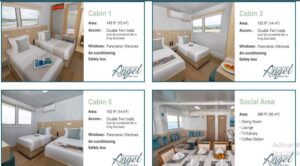



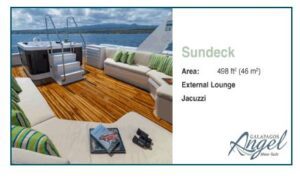
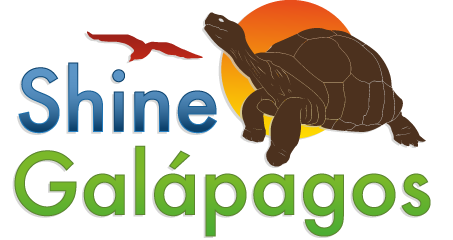
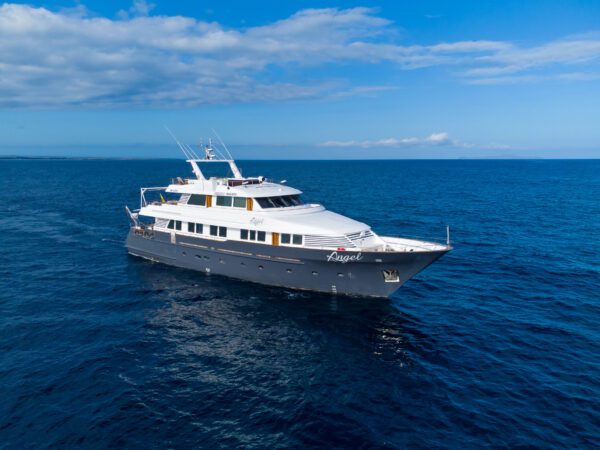









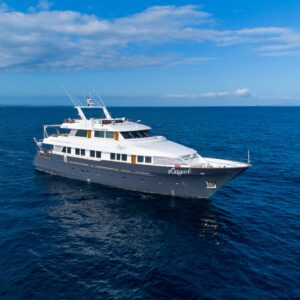
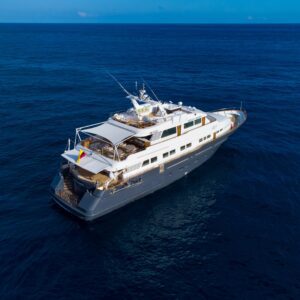
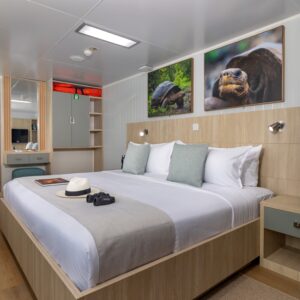
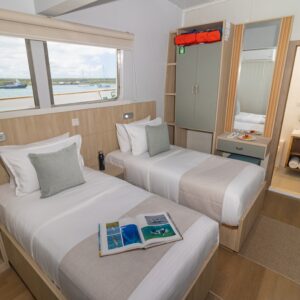






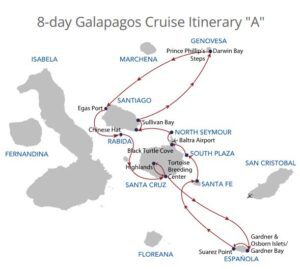
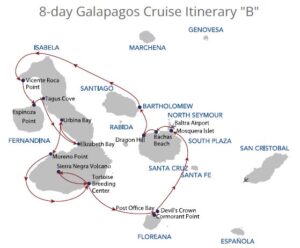
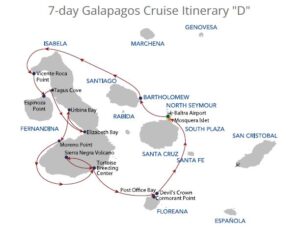
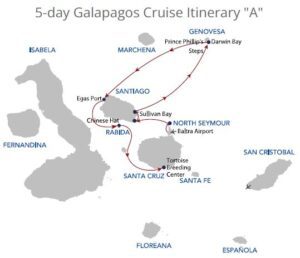
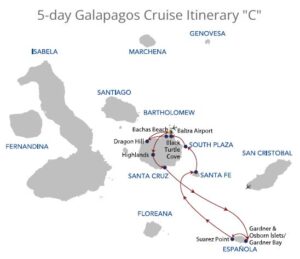
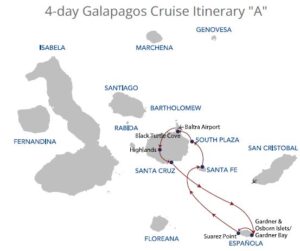

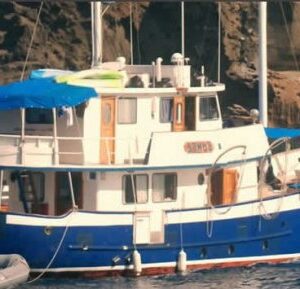
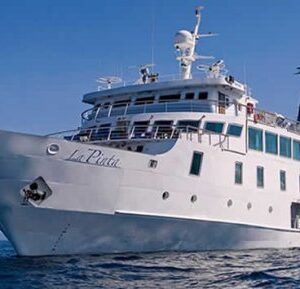

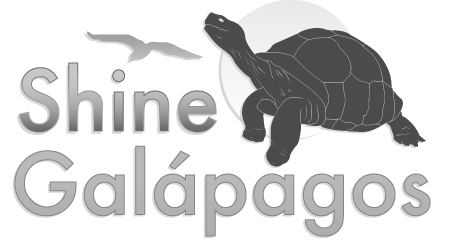
Reviews
There are no reviews yet.